 Friday, December 12th, “Ayurvedic Cooking Class” at The Herb Shoppe, 3912 N. Mississippi Ave, Portland. OR; 6-8pm. $35.
Friday, December 12th, “Ayurvedic Cooking Class” at The Herb Shoppe, 3912 N. Mississippi Ave, Portland. OR; 6-8pm. $35.
Ayurvedic Yoga Training
Ayurvedic Yoga Training! Four full-day Sundays: May 11, June 22, August 3 and September 21 at The Bodhi Tree Studio, 3430 SE Belmont Street, Portland, OR 97214. 10am to 5pm with lunch at Tao of Tea from 1-2pm. $100 for one day, $300 for all four.
Learn to use yoga poses, focused breathwork and daily practices for seasonal and constitutional (Dosha) balance. Expand your Yoga practice with a deeper understanding of Ayurveda and the three Doshas.
Instructors: Ann Wagoner and Susan Bass.
Visit the Ayurvedic Health Fair on March 22nd from 10am to 4pm
 Portland, Oregon hosts its second annual Ayurvedic Health Fair on Saturday, March 22nd from 10 am to 4pm at Tabor Space on 54th Street and SE Belmont. For the past 20 years, renowned herbalist K.P. Khalsa, author of The Way of Ayurvedic Herbs, has said that maybe this year will be the year that Ayurveda finally takes off in Oregon. All signs point to 2014 being a year of change in the Pacific Northwest.
Portland, Oregon hosts its second annual Ayurvedic Health Fair on Saturday, March 22nd from 10 am to 4pm at Tabor Space on 54th Street and SE Belmont. For the past 20 years, renowned herbalist K.P. Khalsa, author of The Way of Ayurvedic Herbs, has said that maybe this year will be the year that Ayurveda finally takes off in Oregon. All signs point to 2014 being a year of change in the Pacific Northwest.
Only last year, Seattle’s Bastyr University launched its Master of Science in Ayurvedic Sciences and became the first such accredited program in the nation. And the year before, NCNM hosted an Ayurveda Seminar Weekend with Dr. Shanbhag, Dr. Sodhi, Dr. Dhru and K.P. Khalsa. Ayurvedic Practitioners in Oregon plan to launch further programs in 2014. Come to the Ayurvedic Health Fair and meet practitioners from the region. Find out more about this healing system and how it can benefit you. It is cost effective, pro-nature, holistic, safe and a complete diet and lifestyle system. You can boost your immunity, improve your digestion, find better sleep and less stress. Find out more about what Dosha you are and what simple tips could bring you in to balance. Guest speakers will present on how:
- Food can be your medicine
- Ayurvedic approaches to women’s health
- Introductory tips from the secrets of Ayurveda
- Diabetes can be addressed with Ayurvedic protocols
- Yoga and Ayurveda’s combined benefits
- Spices to balance your Dosha
The Spring Equinox is one of the best times of year for cleansing. Take advantage of the moment and bring the bliss within yourself to a fuller opening. The event is FREE. For more on tabling or directions, visit the Ayurvedic Health Fair.
Frittata
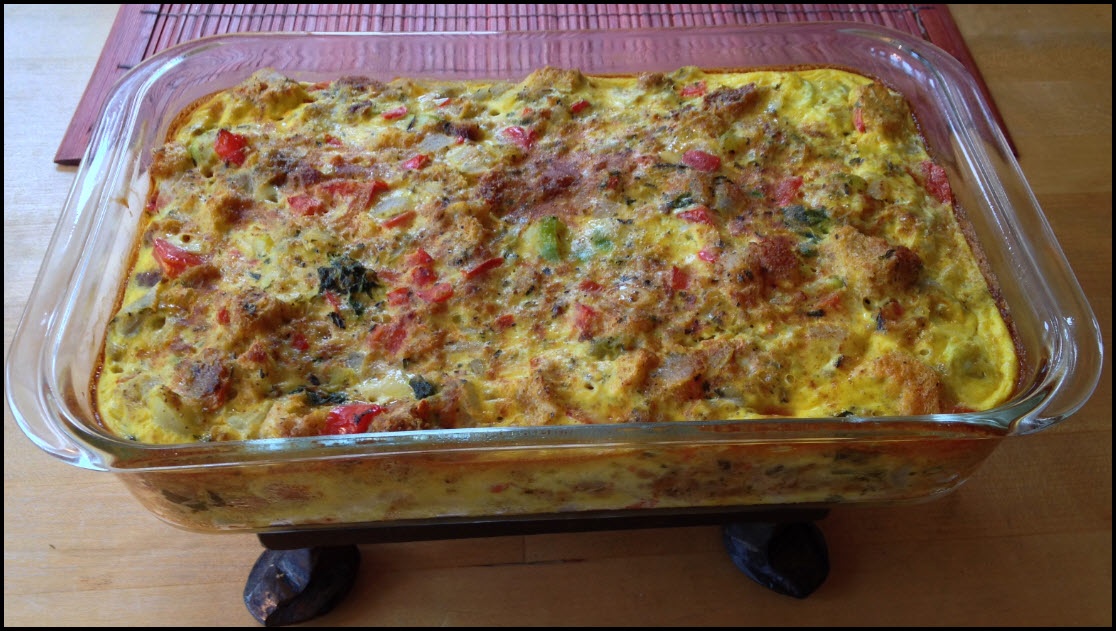
Vata: Decreases
Pitta: Neutral
Kapha: Neutral
Season: Fall
This vegetable frittata is made with local Pacific Northwest vegetables from the Sauvie Island community supported agriculture. I find this a great way to use up zucchini. I’ve served frittata for a brunch with zucchini carrot cake as a complement for a meal of “Zucchinis in Flight”. If you’re going all out, prepare a raw zucchini salad dressing from Gabriel Cousen’s raw food book. Zucchini blends with other foods so well, it’s hard to recognize.
Ingredients:
- 6 eggs
- 2 T olive oil
- 1 1/2 cups onion
- 4-5 slices old bread, cubed and dried 2-3 days (1 1/2 cup)
- 1 bunch chard, with stems
- 1 cup grated zucchini
- 1 medium carrot
- 1 diced red pepper
- 1 tomato
- 1 kohlrabi
- 1/2 teaspoon basil, tarragon, oregano, thyme, parsley, marjoram
- 3/4 t salt
- 1/2 t black pepper
Directions:
- Preheat the oven to 350*F
- Saute onion in olive oil with spices, add bread crumbs
- Add chopped veggies (except greens) and steam 10 minutes
- Allow the greens to wilt after being added
- Pour vegetables tossed with bread into a greased 7 X 9 baking dish
- Beat eggs and pour over the top
- Sprinkle with Hungarian paprika
- Bake 25 minutes or until firm
Serves: 6
Preparation time: 20 minutes
For Individual Doshas:
Vata: Add 1/2 cup grated cheese
Pitta: Top with cilantro
Kapha: Add hot red pepper
Spring Spices
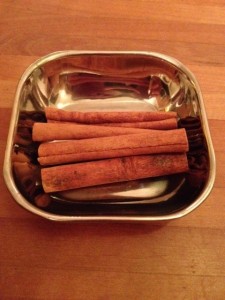
Vata: Neutral
Pitta: Increases
Kapha: Decreases
Season: Spring
Kitchen spices aid in daily digestion and disease prevention. Fresh ginger, lemon and salt promote salivation at the beginning of digestion for those without an appetite. Roasted fennel seeds after a meal helps digestion and preserve dental health. What spices are best in the Springtime?
Which Spices should each Dosha prefer?
KAPHA (Spring) – All Spices! (except salt): Black pepper, cumin, turmeric, ginger, garlic, coriander, clove, anise, cayenne, caraway, cinnamon, mace, marjoram, mustard seeds, orange peel, oregano, parsley, pippali, sage, tarragon, thyme
VATA (Fall and Winter) – Fresh ginger, vanilla, fennel, cumin, garlic, black pepper, clove, saffron, fenugreek, basil, asafoetida (hing), bay leaf, cardamon, cinnamon, nutmeg, orange peel (no caraway)
PITTA (Summer) – Saffron, peppermint, turmeric, coriander, cardamon, rose, curry leaf, dill, fennel, basil (no pungent spices)
Detox Spices & Recommended Daily Quantities (by Dosha)
Daily Dosha Balancing
| Culinary Spice | Daily Quantity | Least | Middle | Most Quantity |
| Turmeric | 1 to 2 t | Vata – 1teaspoon | P – 1.5 t | Kapha – 2 t |
| Cumin | ¼ to 1/2 t | P – ¼ teaspoon | V – 1/3 t | K – ½ t |
| Garlic (roasted) | few cloves | P – <1 clove | V – 2 | K – >4 |
| Cinnamon | 1/8 to 1/2 t | P – 1/8 t | V – 1/4 t | K – 1/2 t |
| Ginger | 1 to 2 tsp | P – 1 t | K 1.5 t | V – 2 t |
| Coriander | 1 to 2 tsp | V – 1 t | P – 1/5 t | K – 2 t |
| Clove | 1 to 2 buds | P – half bud | V – 1 | K – 3 |
| Black Pepper | 1/8 to ¼ tsp | P – 1/8 t | V – 1/8 t | K – ¼ t |
| Saffron | 3 to 5 threads | K – 3 threads | V – 4 | P – 5 |
| Basil | ½ to 1 t dry | P – 1/3 t | V – ½ t | K – 1 t |
| Cardamom | 2-4 pods | P – 2 pods | V – 3 pods | K – 4 pods |
Note: If you’re a Pitta and you’re wondering where Fennel is–be sure to add it back to the list. Take between 1-4 teaspoons daily.
How Rama Got Her Name
Podcast: Play in new window | Download
Brown Rice Pudding

Vata: Decreases
Pitta: Decreases
Kapha: Neutral
Season: Fall
This tasty holiday rice pudding includes healthy brown rice with fiber, brown sugar (or jaggery) and warming spices for the fall and winter. The brown rice adds a nice nutty flavor and texture to the pudding. Stay nourished and warm with a grounding dessert. Save the recipe for summer, chill the pudding and serve on a hot summer day. Turmeric is a carminative and an alterative and turns the pudding a lovely golden color like saffron. Saffron purifies the blood, cardamon improves digestion, nutmeg restores the nervous system, cinnamon reduces cholesterol and milk strengthens the bones. As you bring more spices into your foods, you’ll be more healthy and relaxed. In countries where turmeric is used daily, the incidence of cancer is greatly reduced. Get rid of your medicine cabinet when you update your spice rack. And let’s see which one is cheaper in the long run. (The pudding in the photo was made with half cow and half coconut milk.)
Ingredients:
- 1 cup short grain brown rice
- 4 cups milk (cow, goat, coconut, almond, hemp or combo)
- 1/2 cup brown sugar, sucanat or jaggery
Optional:
- 1/2 teaspoon cardamon
- 1/4 teaspoon nutmeg
- 1/4 teaspoon cinnamon
- 1/2 teaspoon turmeric
- 4-6 threads saffron
- Sliced almonds or pistachios
- 1/2 cup unsweetened flaked coconut
- 1/3 cup raisins
- 2-4 bananas
Directions:
- Soak rice in water for 30 minutes, rinse and drain
- Add milk and rice to heavy bottom pan, simmer 1 hour
- Sweeten to taste, add optional spices and toppings
- Serve warm or chilled
Serves: 6
Preparation time: 20 minutes (after sprouting)
For Individual Doshas:
Vata: Add mashed bananas to pudding. Top with sliced bananas and cinnamon.
Pitta: Chill and top with nutmeg and pistachios.
Kapha: Substitute rice, hemp or almond milk for the cow milk.
Mung Bean Soup (Sprouted)
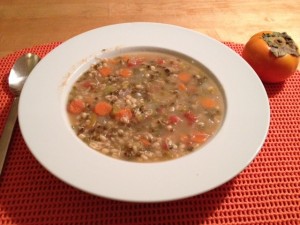
Vata: Decreases
Pitta: Decreases
Kapha: Neutral
Season: Fall, Spring
This mung bean soup is made with sprouted mung beans which increases their digestibility. Soak a cup of whole mung beans overnight, and then drain in the morning. Continue rinsing twice a day until the beans sprout — 2 to 3 days. This will decrease their cooking time by half and be easier for Vata to digest. This soup is full of protein, and vitamin C and B. Add seasonal, local fall vegetables for a delightful and warming dish. Enjoy with fresh hot bread. Yum!
Ingredients:
- 2-3 cups sprouted mung (1 cup unsprouted)
- 4 cups water
- pinch of hing
- 1 onion
- 1 medium carrot
- 1 diced green pepper
- 2 teaspoons grated fresh ginger
- 1 teaspoon cumin powder
- 1 teaspoon coriander powder
- 3/4 t salt
- 1 T apple cider vinegar
- 4 T olive oil
Directions:
- Rinse beans, add water and cook with hing and ginger for 10 minutes
- Blend half, add vegetables and cook for 5-10 more minutes
- Add the rest of ingredients and serve!
Serves: 6
Preparation time: 20 minutes (after sprouting)
For Individual Doshas:
Vata: Top with roasted garlic in olive oil
Pitta: Add fresh cilantro
Kapha: Top with black pepper
Learn more with the Institute of Ayurvedic Yoga Therpay. Classes start in September 2015.
Cilantro Chutney
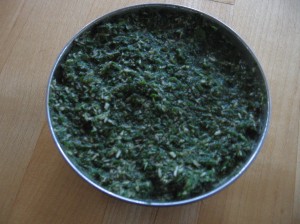
Vata: Decreases
Pitta: Decreases
Kapha: Decreases
Season: Fall, Spring
Cilantro Chutney can be added to your Kitchari for a bit more spice and flavor. It can also be made with parsley for more of a kidney cleanse, or diuretic. This simple chutney can be served with curries, rice and dahl. It can also be used on sandwiches. In the fall, this is a great way to enjoy all the fresh cilantro!
Ingredients:
- 1 bunch cilantro (fresh coriander)
- 2 cloves garlic
- 1/4 t minced ginger
- 1/2 t salt
- juice of 1/2 lemon or lime
- 1/2 green chili, no seeds
- 2-3 T water
- 1/2 cup dry coconut
- 2 t maple syrup
Directions:
- Wash cilantro, take out larger stems
- Blend with garlic, ginger, salt, lemon, pepper,
- Add the rest of ingredients and water as needed to make a paste
Serves: 6
Preparation time: 5-10 minutes
For Individual Doshas:
Vata: Prefer lemon to lime
Pitta: Omit garlic
Kapha: Add 1/4 t black pepper
Zucchini Twirls
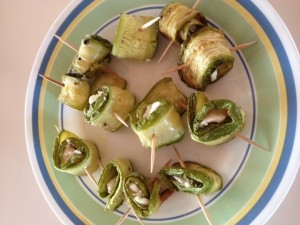
Vata: Decreases
Pitta: Decreases
Kapha: Neutral
Season: Early Fall
These zucchini roll-ups are a wonderful gluten-free appetizer for fall. Roasted zucchini and goat cheese makes a tasty combination. Tofutti or other tofu-alternative cheese can also be used. The goat cheese is nourishing for the cooler weather and the roasted zucchini helps to reduce the last of Pitta left from summer. It’s an easy and fast dish, that can also be prepared ahead of time. Vatas often have an easier time with goat than cow milk (and cheese.) Celebrate your fall harvest in style!
Ingredients:
- 2 zucchini sliced lengthwise
- 1 t basil
- 1 T oil
- Salt and pepper to taste
- 8 oz chevre, or other goat or soft cheese
Directions:
- Slice zucchini lengthwise
- Roast on an oiled pan at 350*F for 10-20 minutes or sautee over medium heat
- Turn the zucchini slices over and roast on the other side until soft
- Add salt, basil and pepper to taste
- Cool and add 1 t cheve to each slice and roll up
- Arrange on a serving dish
Serves: 6 (as an appetizer)
Preparation time: 20-30 minutes
For Individual Doshas:
Vata: Add half an olive inside each roll (or a piece of sun dried tomato)
Pitta: Try a soft cow cheese
Kapha: Add a dash of cayenne
